Yojana Summary: April, 2024 – Our Ecosystem
1. Geological Ecosystem
Overview:

- The Himalayas, the highest mountain range in the world, span approximately 2,400 km and serve as a natural boundary between the Indian subcontinent and the Tibetan Plateau.
- Formed by the collision of the Indian plate with the Eurasian plate, the Himalayas consist of four parallel mountain ranges, each contributing to the region’s diverse landscape.
Key Features:
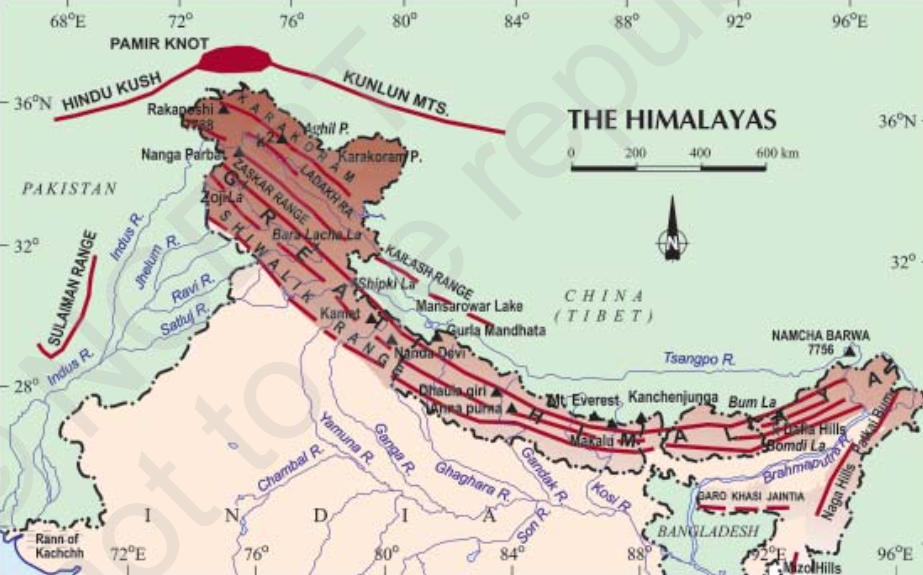
- Great Himalayan Range:
- Home to some of the world’s highest peaks, including Mount Everest and Kanchenjunga, the Great Himalayan Range is characterized by towering peaks and glaciers, such as the Gangotri and Satopanth glaciers.
- Shivalik Hills:
- The southernmost range of the Himalayas, the Shivalik Hills, form a natural boundary between the plains and the mountains, featuring foothills, valleys, and dense forests.
- Tibetan Himalayas:
- The northernmost range, the Tibetan Himalayas, extends into Tibet and is known for its rugged terrain and sparse vegetation, contributing to the region’s unique biodiversity.
The Northern Plains
Overview:
- Known as the Great Plains of India, the Northern Plains are an extensive alluvial tract formed by sediment deposits from rivers originating in the Himalayas.
Key Features:
- Bhabar and Terai Belts:
- The Bhabar belt, a narrow strip along the foothills, consists of porous sediment deposits, while the Terai belt, located south of the Bhabar, is densely forested and rich in biodiversity.
- Bhangar:
- Above the floodplain lies Bhangar, an older alluvium terrace characterized by calcareous pebbles, which serves as a platform for agricultural activities.
- Sundarbans Delta:
- The sediment-laden rivers form the largest delta in the world, the Sundarbans, known for its mangrove forests and diverse wildlife, including the Bengal Tiger and estuarine crocodile.
The Peninsular Plateau
Overview:
- The Peninsular Plateau, the largest physiographic entity in India, features a table-land topography dissected by rivers and valleys.
Key Features:
- Mountain Ranges:
- Extending from the Aravalli Range to the Chota Nagpur Plateau, the Peninsular Plateau encompasses important mountain ranges such as the Vindhyans, Satpuras, and Western and Eastern Ghats.
- Mineral Wealth:
- Rich in mineral resources, the plateau contains deposits of iron, bauxite, coal, and gold, supporting mining activities in regions like Singhbhum and Korba.
- Fertile Soil:
- Much of the plateau is covered with fertile black soil, ideal for agriculture, particularly cotton cultivation, contributing to the region’s agricultural productivity.
The Thar Desert
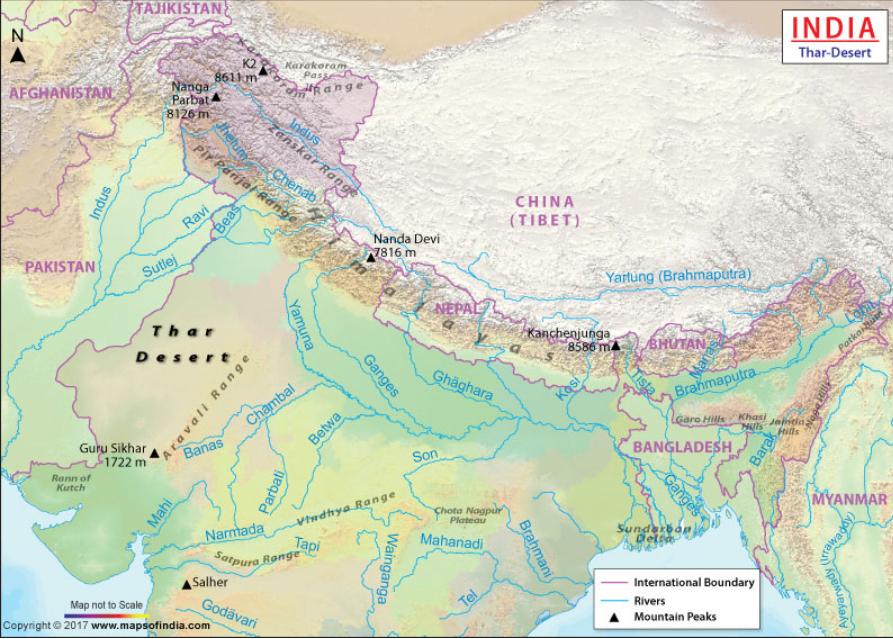
Overview:
- The Thar Desert, also known as the Great Indian Desert, is a vast arid region characterized by sand dunes, rocky terrain, and sparse vegetation.
Key Features:
- Sand Dunes and Nullahs:
- Sand dunes, known as ‘bhakhar,’ dominate the landscape, reaching heights of up to 150 meters, while dry riverbeds, or nullahs, occasionally fill with water during monsoon seasons.
- Natural Resources:
- Rich in oil reserves, the Thar Desert is home to significant onshore oil fields, contributing to India’s energy production.
- Salt Marshes:
- The region features the Great Rann of Kutch, one of the largest salt marshes globally, supporting salt production and unique ecological habitats.
Andaman and Nicobar Islands
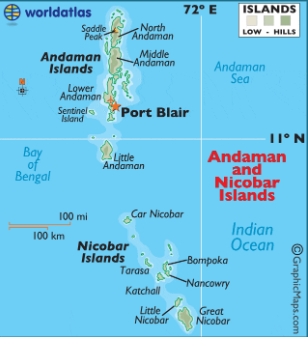
Overview:
- An archipelago of around 572 islands, the Andaman and Nicobar Islands are known for their pristine beaches, tropical forests, and diverse marine life.
Key Features:
- Volcanic Origin:
- Mainly of volcanic origin, these islands were formed by lava eruptions due to tectonic plate movements, with Barren Island being the only active volcano in India.
- Marine Biodiversity:
- The islands boast rich marine biodiversity, supporting coral reefs, tropical fish species, and unique ecosystems, making them popular destinations for ecotourism and diving.
Lakshadweep Islands
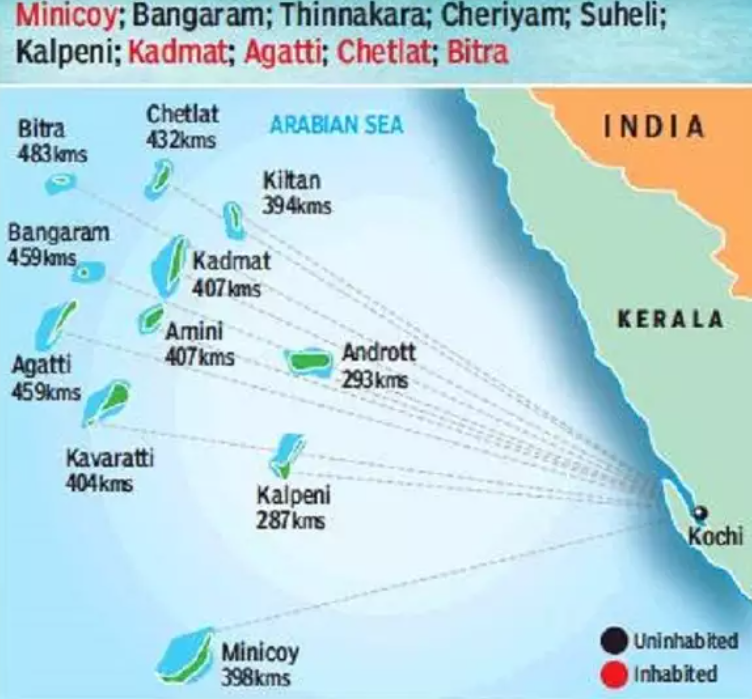
Overview:
- An archipelago of 36 coral islands, Lakshadweep is known for its coral reefs, marine life, and turquoise waters.
Key Features:
- Coral Islands:
- Mainly coral islands, Lakshadweep features unique marine flora and fauna, including coral reefs, sea turtles, and vibrant fish species.
- Ecotourism:
- The islands attract visitors interested in ecotourism, offering opportunities for snorkeling, diving, and exploring pristine natural habitats.
Conclusion
- India’s geographical and geological diversity, ranging from the Himalayas to the Thar Desert and coastal islands, shapes its unique landscape and natural resources.
- These diverse ecosystems not only define India’s mineral wealth but also provide habitats for diverse flora and fauna, supporting agriculture, tourism, and economic development.
2. From Peaks to Valleys: Holistic Exploration of Western Ghats
Overview of the Western Ghats
- The Western Ghats, also known as the Sahyadri Mountain Range, are recognized as a global biodiversity hotspot and hold the prestigious UNESCO World Heritage Site designation.
- Encompassing regions in six states and one Union Territory, namely Gujarat, Maharashtra, Goa, Karnataka, Kerala, Tamil Nadu, and Dadra & Nagar Haveli, the Western Ghats span a vast geographical area.
Subdivision of Western Ghats
- The Northern Ghats: Stretching from Gujarat to Maharashtra, this segment represents the lowest and least rugged section of the Western Ghats.
- The Central Ghats: Extending from Karnataka to Kerala, this section comprises the highest and most rugged terrain of the Western Ghats.
- The Southern Ghats: Spanning from Kerala to Tamil Nadu, this area represents the most dissected section of the Western Ghats.
Topography and Natural Resources
- Elevation: The Western Ghats boast an average elevation of around 1,200 meters, with peaks exceeding 2,000 meters. Anamudi, located in Kerala, stands as the highest peak at 2,695 meters.
- Northern vs. Southern Segments: The northern section is generally lower, while the southern section is steeper and more rugged.
- Gaps: Major gaps interrupt the mountain range, including the Palghat Gap, Shencottah Gap, and Goa Gap, each contributing to the region’s unique geography.
Biodiversity Overview
- Endemic Species: Over 50% of the tree species in the Western Ghats are endemic, highlighting its rich biodiversity.
- Forest Types: The slopes of the Western Ghats are covered with diverse forest types, including evergreen rainforests, semi-evergreen forests, deciduous forests, and moist deciduous forests.
Threats to the Western Ghats
- Habitat Loss: Deforestation, encroachment, and unsustainable land-use practices pose significant threats to the biodiversity of the Western Ghats.
- Climate Change: Rising temperatures and changing weather patterns can disrupt ecological balance and endanger species adapted to specific climatic conditions.
Conservation and Management
- Protected Areas: Various protected areas, including national parks like Silent Valley National Park, wildlife sanctuaries like Dandeli Wildlife Sanctuary, and biosphere reserves like Nilgiri Biosphere Reserve and Agasthyamalai Biosphere Reserve, contribute to conservation efforts.
- Way Forward: Conservation and management efforts for the Western Ghats require collaborative initiatives involving the government, local communities, NGOs, and research institutions to ensure sustainable development and biodiversity preservation.
The Western Ghats stand as a testament to India’s rich ecological heritage and serve as a critical habitat for numerous endemic species. However, concerted efforts are needed to address the threats facing this ecologically significant region and ensure its long-term conservation and sustainable management.
3. Soil Ecosystem
Components of the Soil Ecosystem
- Physical Environment: Texture, structure, and moisture content form the foundation, influencing organism distribution and behavior.
- Organic Matter: Dead plant and animal material, along with living organisms like microbes, fungi, and earthworms, provide nutrients and energy, crucial for soil fertility and structure.
- Micro-organisms: Bacteria, fungi, protozoa, etc., facilitate nutrient cycling, decomposition, and soil health, contributing to soil aggregates’ formation.
- Macro-organisms: Earthworms, insects, nematodes, and small mammals aid in nutrient cycling, soil aeration, and structure formation, influencing soil fertility.
- Plant Roots: Exudates from roots fuel microbial activity, shaping soil microbial communities and nutrient cycling processes.
Functions of the Soil Ecosystem
- Nutrient Cycling: Soil organisms decompose organic matter, releasing essential nutrients like nitrogen, phosphorus, and potassium, vital for plant growth and productivity.
- Decomposition: Microorganisms and detritivores break down organic matter, recycling nutrients and enhancing soil fertility and organic matter accumulation.
- Soil Formation: Through weathering and biological processes, soil develops over time from parent material.
- Water Regulation: Soil acts as a reservoir, storing and releasing water slowly, influencing infiltration, retention, and drainage, crucial for plant growth and flood mitigation.
- Habitat Support: Soil provides a habitat for diverse organisms, from bacteria to mammals, contributing to ecosystem biodiversity.
Interconnections in the Soil Ecosystem
- Complex Relationships: Components of the soil ecosystem are interconnected through intricate networks, such as plant roots exuding compounds that fuel microbial growth, aiding nutrient uptake and soil structure formation.
Conclusion
- Dynamic Community: The soil ecosystem sustains life on Earth, playing a critical role in terrestrial ecosystems and human wellbeing.
- Importance of Understanding: Recognizing the complexity of the soil ecosystem is vital for sustainable land management and ecosystem conservation, ensuring soil health for future generations.
4. Sacred Groves
Types of Sacred Groves
- Temple Groves: Protected by the government, temple trust, or village committees due to religious significance associated with temples.
- Traditional Sacred Groves: Places where folk deities reside, containing rich biodiversity.
- Religious Groves: Associated with various religions like Hinduism, Buddhism, Jainism, Islamism, and Sikhism.
- Island Groves: Found in habitat-specific ecological areas like mangroves and coastal regions in Andhra Pradesh.
- Burial/Cremational/Memorial Groves: Associated with burial places, revered as places inhabited by ancestral spirits.
Significance of Sacred Groves
- Protection of Ecosystems: They serve as protected areas, preserving biodiversity by limiting harmful human activities.
- Traditional Knowledge: Local communities managing sacred groves possess deep ecological understanding and traditional practices.
- Biodiversity Conservation: Act as refuges for diverse plant and animal species, mitigating habitat loss threats.
- Cultural Preservation: Preserve cultural and religious practices of local communities.
- Community Empowerment: Managed by local communities, promoting their involvement in conservation efforts.
- Environmental Benefits: Maintain ecological balance and provide ecosystem services.
- Community Conservation: Protect biodiversity and manage natural resources sustainably for future generations.
Biodiversity Heritage Site
- Unique Conservation Approach: Recognized under Section 37(1) of the Biological Diversity Act, 2002, allowing State Governments to notify areas of biodiversity importance as Biodiversity Heritage Sites.
- Number of Sites: 44 Biodiversity Heritage Sites have been notified by 16 states.
Challenges
- Habitat Loss: Sacred groves face threats from urbanization and encroachment.
- Climate Change: Global warming and climatic changes disrupt ecological balance.
- Invasive Species: Introduction of alien species threatens native biodiversity.
- Anthropogenic Pressure: Human activities like deforestation and pollution degrade sacred grove ecosystems.
- Legislative Gaps: Lack of proper legislation poses challenges to their protection.
Conclusion
- Legal Protection: Sacred groves are legally protected under community reserves by the Wildlife (Protection) Amendment Act, 2002.
- Community Conservation: They exemplify community conservation and in-situ biodiversity conservation.
- Modern Challenges: Despite legal protection, sacred groves face threats from urbanization, cultural shifts, anthropogenic pressure, and climate change, leading to their erosion and loss of ecological and cultural significance.
5. Blue Economy
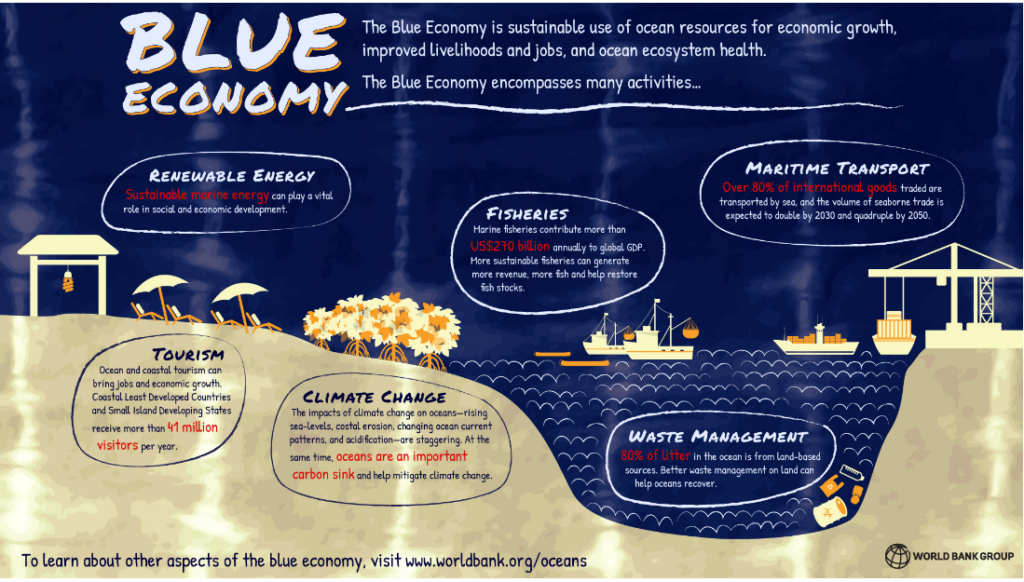
Blue Economy Definition and Global Context
- Definition: The World Bank defines the blue economy as the sustainable development of ocean resources for economic growth, improved livelihoods, and jobs while preserving the health of the ocean ecosystem.
- Global GDP Contribution: Approximately 3-5% of global GDP is derived from ocean-related activities, emphasising its potential for economic growth and job creation.
- Maritime Transport: Over 80% of international goods are transported by sea, highlighting the critical role of maritime transport in global trade.
- UN Decade of Ocean Science: The UN has declared 2021-2030 as the ‘UN Decade of Ocean Science for Sustainable Development’, underlining the importance of ocean research and conservation.
India’s Blue Economy Landscape
- Coastline and Ports: India boasts a coastline of over 7500 km and has an Exclusive Economic Zone (EEZ) exceeding 2.2 million sq km. It comprises 200 ports, including 12 major ports, handling significant cargo volumes.
- Fisheries: India ranks as the second-largest fish-producing nation globally, with a fleet of 2,50,000 fishing boats.
- Economic Contribution: India’s blue economy currently contributes roughly 4% to the GDP, with potential for further growth.
Activities in Blue Economy
- Renewable Energy: Focus on offshore wind and wave energy for sustainable development and reduced reliance on non-renewable sources.
- Fisheries: Sustainable management practices ensure continuous revenue and fish stock restoration, supporting economic and environmental objectives.
- Maritime Transport: Crucial for global trade and economic connectivity, facilitating the movement of goods across nations.
- Tourism: Coastal and marine tourism offer recreational opportunities, job creation, and economic growth, contributing significantly to the blue economy.
- Climate Change: Oceans play a vital role in climate regulation, acting as carbon sinks through ‘blue carbon’ absorption.
- Waste Management: Proper disposal practices prevent pollution and environmental degradation, promoting ocean recovery.
Importance of the Blue Economy for India
Ocean and Resources
- Fisheries: Significant revenue generation and supply contribution, with marine and inland fisheries playing a vital role in India’s economy.
- Minerals: India’s continental margins host diverse mineral deposits, including heavy minerals and hydrocarbons.
- Renewable Energy: Exploiting renewable energy sources like offshore wind and waves holds immense potential for sustainable energy production.
- Ports, Shipping, and Tourism: Integral to trade, employment, and economic growth, with maritime tourism emerging as a key sector.
Ocean Science and Services
- Observations and Services: Ocean and coastal observations, data, and information services are crucial for safety and efficiency in marine activities.
- Climate Change Impact: Climate change threatens marine ecosystems and livelihoods, necessitating conservation efforts and sustainable resource use.
- Marine Biodiversity Conservation: Sustainable management of marine biodiversity is essential for maintaining ocean health and ecosystem services.
- Research Gap: The evolving blue economy requires continued research in various disciplines to address challenges and harness opportunities effectively.
Niche Areas and Employment
- Coastal and Marine Spatial Planning: Science-based planning ensures efficient allocation of coastal and marine resources for economic development and conservation.
- Source of Employment: Traditional sectors like fishing and aquaculture, along with emerging fields like offshore wind and marine biology, offer diverse employment opportunities.
- Skill Development Initiatives: Training programs and skill development initiatives are vital for engaging the workforce and ensuring sustainable growth.
Conclusion
- Evolution of Blue Economy: From traditional fishing practices to innovative sectors like offshore wind, the blue economy is evolving rapidly.
- Youth Involvement and Tradition: Skill development initiatives, youth involvement, and preservation of traditional knowledge are essential for maximising the blue economy’s potential and ensuring prosperity for all stakeholders.
6. The Ramsar Convention on Wetlands
Ramsar Convention Overview
- International Treaty: The Ramsar Convention is an international treaty aimed at the conservation and sustainable use of wetlands.
- Also Known As: It is commonly referred to as the Convention on Wetlands.
- Origin: Named after the city of Ramsar in Iran where the treaty was signed on February 2, 1971.
- World Wetlands Day: February 2nd of each year is celebrated as World Wetlands Day to raise awareness about the importance of wetlands.
- Parties to the Convention: Currently, there are 172 parties to the convention, demonstrating global commitment to wetland conservation.
Objectives and Functions
- Wise Use of Wetlands: The convention aims for the wise use of wetlands, maintaining their ecological character within the context of sustainable development.
- Policy-Making Organ: The Conference of the Contracting Parties (COP) serves as the policy-making organ of the convention, adopting decisions to administer its work.
- Meetings: Representatives of the Contracting Parties convene every three years to discuss and address wetland-related issues.
Importance of Wetlands
- Depletion: Wetlands are rapidly depleting, with 64% of the world’s wetlands lost in the last century.
- Ecosystem Services: They provide essential ecosystem services such as freshwater supply, biodiversity support, flood control, groundwater recharge, and climate change mitigation.
Wetland Definition
- Inclusion: Wetlands encompass various types of habitats, including lakes, rivers, swamps, marshes, estuaries, mangroves, and human-made sites like fishponds and reservoirs.
- Critical Ecosystems: They are vital for supporting biodiversity and providing habitat for numerous species.
Montreux Record and Ramsar Sites
- Register: The Montreux Record serves as a register of wetland sites where changes in ecological character have occurred or are likely to occur due to human interference.
- Criteria for Ramsar Site: A wetland must meet at least one of nine criteria defined by the Ramsar Convention to be designated as a Ramsar site.
Ramsar Criteria
- Species Support: Wetlands supporting vulnerable, endangered, or critically endangered species or threatened ecological communities qualify.
- Waterbird Population: Sites regularly supporting 20,000 or more waterbirds are eligible for Ramsar designation.
- Fish Dependency: Wetlands serving as important sources of food for fishes, spawning grounds, nurseries, or migration paths for fish stocks meet the criteria.
Conclusion
- Global Importance: The Ramsar Convention plays a crucial role in protecting and conserving wetlands, which are invaluable ecosystems supporting biodiversity and providing essential services to humanity.
- Conservation Efforts: By adhering to the convention’s objectives and criteria, nations can ensure the sustainable management and preservation of wetland ecosystems for current and future generations.
Some of the important wetlands of India are mentioned below:
- Ankasamudra Bird Conservation Reserve (Karnataka): Designated in January 2024, it serves as a vital habitat for various bird species.
- Aghanashini Estuary (Karnataka): Added in January 2024, it is a significant estuarine ecosystem supporting diverse flora and fauna.
- Magadi Kere Conservation Reserve (Karnataka): Recognized in January 2024, it conserves the unique biodiversity of Magadi Lake.
- Longwood Shola Reserve Forest (Tamil Nadu): Added in January 2024, it protects the biodiversity of shola forests.
- Karaivetti Bird Sanctuary (Tamil Nadu): Designated in January 2024, it provides sanctuary for various bird species.
- Chilika Lake (Odisha): Largest brackish water lagoon, vital for migratory birds and supports local livelihoods.
- Keoladeo National Park (Bharatpur, Rajasthan): Renowned avifauna sanctuary, a UNESCO World Heritage Site.
- Harike Wetland (Harike, Punjab): Important bird area and Ramsar site in Punjab.
- Loktak Lake (Bishnupur, Manipur): Largest freshwater lake in northeast India, known for phumdis and Sangai deer.
- Sambhar Lake (Rajasthan): Largest saltwater lake in India, crucial for migratory birds.
- Wular Lake (Jammu and Kashmir): Largest freshwater lake in India, significant for biodiversity and local livelihoods.
- Kanjli Wetland (Kapurthala, Punjab): Important bird area and Ramsar site in Punjab.
- Ropar Wetland (Ropar, Punjab): Ramsar site and important bird area in Punjab.
- Ashtamudi Wetland (Kollam district, Kerala): Ramsar site known for its biodiversity and scenic beauty.
- Bhitarkanika Mangroves (Odisha): Largest mangrove ecosystem in India, home to diverse flora and fauna.
- Bhoj Wetland (Bhopal, Madhya Pradesh): Important bird area and Ramsar site in Madhya Pradesh.
- Deepor Beel (Guwahati, Assam): Ramsar site and important bird area in Assam.
- East Kolkata Wetlands (Kolkata, West Bengal): Ramsar site known for its unique wastewater management system.
- Kolleru Lake (Andhra Pradesh): Largest freshwater lake in Andhra Pradesh, significant for bird migration.
- Point Calimere Wildlife and Bird Sanctuary (Tamil Nadu): Important bird area known for migratory birds and wildlife sanctuary.


